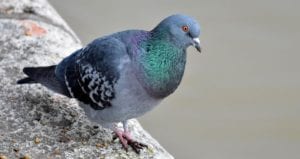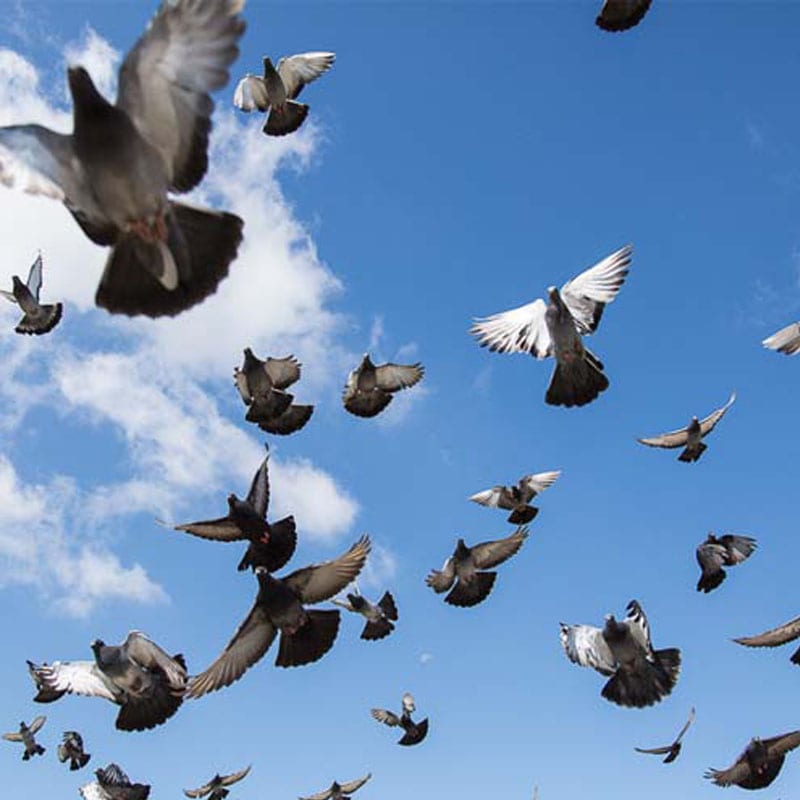
by Pigeon Patrol | Jun 14, 2023 | Bird Spike, Pigeon Droppings, Pigeon Patrol's Services, Pigeon Predators, Pigeon Spikes, Pigeons, Pigeons in the News
While pigeons are well known for living in cities, they’ll find their habitats anywhere. And whether you have an outdoor space that’s acres large or just a tiny balcony, you’ll likely receive visits from pigeons from time to time. A few pigeon coos or some droppings on your driveway may not be a huge concern. But if those harmless visits are turning into a constant nuisance, like excessive noise or cars coated in droppings, and you need to know how to deter pigeons, the steps below provide plenty of solutions to this problem.
So how do you get rid of pigeons? Start by eliminating any access to food sources, then follow up with deterrents that prevent them from landing or nesting near your home. It sounds simple, but if the problem of how to get rid of pigeons becomes too overwhelming, it may be best to call in the help of a professional from one of the best pest control companies that also offer wildlife control.
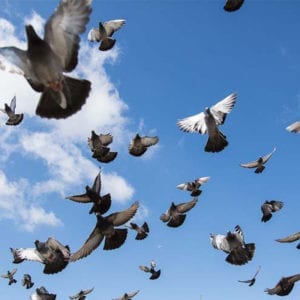
Before You Begin…
When wondering how to keep pigeons off your roof or how to keep pigeons off a balcony, it’s important to note that although they may seem harmless, pigeons can pose more of a problem than you may initially think. Pigeons are communal creatures, and large gatherings can cause excessive noise. Pigeon droppings are relatively acidic, and they can eat away at roofing materials and car paint if not removed. Plus, pigeon droppings can obscure a home’s solar panels, meaning that the solar panels can’t work as efficiently.
Droppings can also spread disease, and exposure to the birds could cause illness, especially in those who are immunocompromised. Pigeons themselves can carry a variety of parasites, such as ticks. If you have a significant pigeon problem, it may be worth contacting a professional who can use the proper tools and techniques to keep the birds away. It may even help to call an expert for advice before you invest time and money into various DIY methods—what may seem like a minor issue to you could be a larger-scale problem that definitely requires a pro’s help. Talking to a professional first can help you determine the full scope of the pigeon problem and what exactly will be needed to fix it.
Tips for Getting Rid of Pigeons
- Remove or secure any potential food sources, such as trash cans or compost receptacles.
- Apply bird spikes, netting, and reflective tape or shock strips, and set up a faux owl or hawk figure near the spot they frequent most.
Safety Considerations
- If the pigeons leave a significant number of droppings around the home, exposure could cause illness.
- Before attempting to trap or remove a pigeon from the inside of the home, it’s wise to contact an exterminator or animal control specialist first.
Source
Pigeon Patrol Products & Services is the leading manufacturer and distributor or bird deterrent (control) products in Canada. Pigeon Patrol products have solved pest bird problems in industrial, commercial, and residential settings since 2000, by using safe and humane bird
deterrents with only bird and animal friendly solutions. At Pigeon Patrol, we manufacture and offer a variety of bird deterrents, ranging from Ultra-flex Bird Spikes with UV protection, Bird Netting, 4-S Bird Gel and the best Ultrasonic and audible sound devices on the market today.
Voted Best Canadian wholesaler for Bird Deterrent products ten years in a row.
Contact us at 1 877-4-NO-BIRD,(604) 585-9279 or visit our website at www.pigeonpatrol.ca
Pigeon/Pigeon Patrol / Pigeons Roosing / Vancouver Pigeon Control / Bird Spikes / Bird Control / Bird Deterrent / PIgeon Deterrent / Surrey Pigeon Control / Pest / Seagull deterrent / Vancouver Pigeon Blog / Birds Inside Home / Pigeons in the cities / Ice Pigeons / What to do about pigeons / sparrows, Damage by Sparrows, How to Keep Raccoons Away, Why Are Raccoons Considered Pests / De-fence / Pigeon Nesting / Bird Droppings / Pigeon Dropping / woodpecker control / Professional Bird Control Company / Keep The Birds Away / Birds/rats/seagull/pigeon/woodpecker/dove/sparrow/pidgeon control/pidgeon problem/pidgeon control/flying rats/pigeon problems/ bird netting/bird gel/bird spray/bird nails/bird guard

by Pigeon Patrol | Jun 14, 2023 | Bird Spike, Pigeon Droppings, Pigeon Patrol's Services, Pigeon Predators, Pigeon Spikes, Pigeons, Pigeons in the News
At this time of year (February and March) many lofts will be experiencing respiratory infection in some of their young birds. This usually presents as a few birds with one eye becoming red and watery.
Respiratory diseases are common in pigeons. They are a major cause of poor performance and pigeon loss during the race season. Young birds under stress are most at risk of developing respiratory diseases, although healthy old birds can fall ill when exposed to respiratory diseases in the race basket. For birds to give of their best it is vital that fanciers have an understanding of respiratory infection and how to correctly manage it.

Nature of the disease
Clinical respiratory infection in pigeons is the end result of the interplay of a number of factors, but the type of infective organisms involved and the vulnerability of the birds to infection are particularly important.
The usual organisms involved are Mycoplasma, Chlamydia and a range of bacteria (most commonly, E. coli). Whether or not these organisms actually cause disease in a pigeon, if it is exposed, essentially depends on how well the pigeon is at the time of exposure and also its age and level of immunity. Any factors that cause physiological stress can weaken the bird and make it more vulnerable to developing a respiratory infection. As a general rule, younger pigeons are more susceptible. However, in a bird that is otherwise healthy exposure to the agents that cause respiratory infection does not necessarily make it sick. Exposure to these organisms as the young pigeons grow and develop, rather than cause disease, stimulates immunity to form in a bird that is otherwise healthy.
Predisposing stress factors that can make pigeons more vulnerable to respiratory infection can take the form of:
1. Environmental triggers; e.g. dampness, overcrowding, low hygiene
2. Management triggers; e.g. poor feeding, excessive tossing, or
3. Concurrent disease, in particular parasitism. This includes wet canker. The combination of either worms or elevated trichomonad levels and respiratory disease is very common.
The fancier must establish a healthy loft environment; otherwise respiratory disease will continually recur, despite medication. A good example here is a fancier who was recently in our clinic. He had a group of young birds that had dropped about three flights; that is, were about ten weeks old. A few kept getting ‘eye colds’. He would treat them and they would become well but within two weeks there would be more birds with the same problem. In a 2m x 2m section, he had 40 youngsters, and the humidity reading (from a hygrometer placed on the wall of the loft overnight) was 85%. Reducing the number of birds to 25 per section, and installing an additional vent high on the back wall improved ventilation and reduced humidity. The birds were again treated, but this time the problem did not return.
This article discusses respiratory infection associated with Chlamydia.
Chlamydia
Chlamydia are one of the 2 common organisms that cause respiratory infections in pigeons. Chlamydia are an unusual group of organisms. They are what are called intracellular bacteria , ie they actually live inside the tissues of animals. Being bacteria they are antibiotic responsive. As a group, they can cause disease in a variety of animals. One species causes disease in koalas while another causes a venereal disease in humans. The species that infects pigeons is called Chlamydia psittaci. It essentially has two lifecycle stages – a reticulate body and an elementary body. The elementary body can survive in the environment. Pigeons become infected through contact with the elementary body. The elementary body typically attaches itself to the superficial lining cells of the eyelid, throat or upper respiratory tract. The elementary body then penetrates the cell membrane into the cell and becomes a reticulate body. The reticulate body then replicates itself until there are many reticulate bodies in the cell. As the reticulate bodies increase in number, they rupture into adjacent cells causing cell destruction and an advancing wall of inflammation. Alternatively, they rupture back out on to the surface of the cell, once again becoming elementary bodies and further contaminating the environment. Infected birds with active disease shed large numbers of these infective elementary bodies in their saliva, tears, respiratory discharges and droppings contaminating the loft. Poor loft hygiene enables a build-up of the organism in the loft. Combine this with birds that are a bit run-down and a disease outbreak occurs. However in well managed lofts disease is rare. In fact ,as mentioned above, it is thought that low grade exposure to these Chlamydia elementary bodies may not cause disease but, rather, trigger the development of an immune response in a pigeon that enables it to be more resistant to the disease. The typical situation in most racing lofts is that Chlamydia tends to cycle through the birds. Growing youngsters are passively exposed to the organism from other birds in the loft and their parents. Often this doesn’t cause disease. Most birds, by the time they are six months old, have had multiple low grade exposures and have developed a significant immunity. Disease occurs if the youngsters become ‘run down’ due to stress factors and are therefore unable to mount an immune response or, alternatively, their level of immunity is challenged by a particularly high exposure to the organism. An antibiotic called doxycycline is very effective at treating Chlamydia. If a pigeon is given a 45-day course it has a 98% chance of clearing Chlamydia totally from its system. One would think that it would make sense to treat all the birds for 45 days, eradicating the disease and then not worry about it in the future. The difficulty with this is that if we were to eradicate Chlamydia, it is known that any immunity that the pigeons have would gradually disappear. This would mean that if the birds were subsequently re-exposed, they would be a very vulnerable population and potentially severe disease could occur. Once racing starts, exposure to Chlamydia in the race units is virtually guaranteed. Although drugs can be used to treat Chlamydia again and again if it keeps reappearing in returning race birds this is obviously not desirable. The factor that principally protects the birds in the race unit is the immunity that they are able to form if they are well cared for in the loft while young and maturing . Chlamydia is therefore managed by caring for the birds well ( so that they can mount a good immune response), by allowing a controlled exposure to the disease ( to build up a strong immunity) through the maintenance of loft hygiene and by using medication if required during development in a way that keeps the birds healthy but still allows some exposure to the disease. How is this done?
Post-weaning management
In the post-weaning time Chlamydia cycles through the developing young birds. Some youngsters may have passive immunity acquired through the egg and from their parents in the crop milk. Further exposure in the young bird loft builds on this immunity. Some youngsters take longer to form a protective immunity than others, and these can show symptoms of clinical Chlamydia infection. If the birds are well otherwise, these symptoms are often described as a “one eye cold”. Symptoms are often mild and may include a dirty cere, sneezing, nasal discharge, a partially closed light sensitive eye, inflamed red eyelids, and also tears overflowing the eyelids and becoming air dried on the feathers around the eye. If the number of birds affected is low and the symptoms are mild, often no treatment is provided. With ongoing good care it is likely that the birds will fix themselves and will develop a stronger natural immunity this way. If the symptoms in an individual bird become more severe, particularly if the bird’s development is starting to be compromised, treatment should be provided. The usual treatment is doxycycline 10–25mg per pigeon once daily. If less than 5–10% of birds are affected, it is best to just treat these birds individually. There is no need to separate them from the rest as all birds are likely to have the organism in them. Also young birds tend to recover better if left with the flock in a familiar loft. If more than 10% of birds develop symptoms then a flock treatment should be given. The usual treatment is doxycycline in the water. However, if 10% or more are developing symptoms, this tells you that this group of young pigeons is having trouble developing their natural immunity. And if they are having trouble developing a natural immunity this means that something is stressing them. A review of their management, loft environment and a check for any other (particularly Circo virus and parasitic) disease should be done. In young birds the underlying stress is often overcrowding. In Victoria, Australia, January to May are the respiratory months. Most lofts contain large numbers of young birds having just had the stress of weaning and now having the stress of moulting, coupled with young bird training and establishing themselves in the loft. It is a time of high humidity and fluctuating temperature, conditions that favour respiratory disease. Between 1 December and 1 March (the usual time that the last youngsters are weaned in many lofts in Australia), fanciers must monitor the youngsters, in particular for signs of “one-eye cold”, dirty wattles or sneezing. However, green watery droppings, failure to thrive, shortness of breath and a reluctance to fly may also be indicative of the problem. After 1 March in Australia, as the youngsters get older, fanciers look for signs of poor loft flying, excessive panting after training, and sneezing within the loft. Even in the healthiest lofts, there can be occasional outbreaks of respiratory diseases. It is important to recognise that more than three sneezes within five minutes from 100 birds is a significant indicator of early respiratory disease. One would expect two to three sneezing outbreaks between January and May, even in the best managed loft.
Pre-race management
As racing approaches, the birds have been given as long as possible to develop their natural immunity. It is important, however, that there is no active Chlamydial respiratory infection in the birds when racing starts. The can lead to poor race results and potentially disastrous returns. Chlamydia tests can be done by your veterinarian to see if the disease is still active and if the birds have formed a good immunity. The usual tests available are the Chlamydia immunocomb test, or Chlamydia PCR test.
A team should only be treated for Chlamydial respiratory infection before racing if it fits into one of the following categories:
1. If testing shows that the disease is still active in the birds, even if they look normal.
2. If Chlamydial respiratory infection was a problem during the early part of the racing season the previous year and the loft parameters have not changed (i.e. same loft design, same genetics, etc.)
3. If there was a significant amount of respiratory disease in the post-weaning time.
4. If the birds have a current clinical respiratory infection.
If the loft fits into one of the above categories then it is usual to treat the birds for 7–20 days with doxycycline, finishing two to three weeks before racing starts. Just how long an individual team is treated depends on the severity of the problem and the response to treatment. If they do not fulfil one of these criteria then no treatment is required.
I have had several fanciers tell me that they have been advised by a vet that the best thing to do prior to racing is treat their birds regardless with doxycycline. They were told that if it makes their birds sick then they don’t need it. If it does not make them sick then they must have Chlamydia and a long course of the drug should be given. I find this advice hard to believe as coming from a vet . It would see potentially tens of thousands of pigeons given antibiotics they don’t need in an absolute bogus way of assessing Chlamydia status. Such a suggestion is nonsense.
Management during racing
Ongoing exposure to Chlamydia occurs during the racing season. The natural immunity the birds have formed through development should be high enough to protect them; however, because of the stress associated with racing and potentially high exposure to the organism it may not be. Fanciers should monitor their birds closely for symptoms and have their birds regularly checked by an avian vet. If the birds become unwell or race performance is compromised due to Chlamydia, then the team is treated as a single unit and a flock treatment of doxycycline is given. Birds return to health fairly quickly, but not to race form. Sometimes a race needs to be missed and then the level of work gradually increased as the birds regain their health and fitness. If Chlamydia is diagnosed through the racing season, what should the fancier do?
1. Conduct a health profile– i.e. examination of the saliva and droppings and sometimes other tests as suggested by your veterinarian to assess any concurrent disease that may need treatment. Provide general ongoing good care to ensure a good response to medication.
2. Return to exercise gradually. Always, with respiratory infection, there is an extended convalescence usually of 1–3 weeks. The birds must be given time to recover their fitness once medication has cleared the infection. They should not be forced to fly around the loft and once it is apparent that their vigour for flying has returned, short tosses only should be given (less than ½ – 1 hour) initially. Observe the birds closely for signs of breathlessness on landing from these tosses and only when they are handling these well should longer tosses be given. When managing tosses of 1–1½ hours well, it is usually safe to resume racing. In well-managed lofts with no other health problems, response to treatment can, however, be dramatic and I have had an interesting experience where two fliers both diagnosed with respiratory infection in their teams succeeded in gaining 1st and 2nd Federation (3000 birds) in an all-day 800km race 3 weeks after treatment.
3. Give good food, good care and an appropriate multivitamin supplement to speed recovery.
4. Give appropriate medication. The choice of drug is often dependent on the involvement of secondary organisms, but usually the antibiotics doxycycline and tylosin are given together, or a blend of doxycycline, tylosin and spiramycin. An initial course usually of 3–10 days is given, depending on the severity of the infection and response to treatment.
Symptoms of Chlamydial Respiratory Infection
In young birds, symptoms are usually confined to the upper respiratory tract and the most common signs observed are a dirty cere, nasal discharge and a red watery eye. In some birds, however, the organism can infect various internal organs including the liver and spleen and also deeper parts of the respiratory tract, particularly the air sacs. These birds may just be quiet, be reluctant to fly, lose weight and develop a green mucoid dropping. Birds with inflamed air sacs often become breathless after moderate exercise and are sometimes forced to land wherever they are. This may include buildings or trees near the loft. By the start of racing the birds are older, their natural immunity is higher and their response to disease is different. The signs observed are modified by these factors and are often very subtle. Older birds with respiratory infection have lost their zest for life, and this is reflected in their race results. Birds that are reluctant to fly, quiet in the loft and with dry feathers (no bloom) are suggestive of respiratory infection. Irritation to the upper airway usually shows itself as an increased rate of sneezing. Sneezing (more than three times in five minutes from 100 birds), scratching at the nose, yawning, repeated exaggerated swallowing, stretching the neck and wiping the nose on the wing butt all indicate irritation of the upper airways. On opening the beak, inflamed tonsils may be seen, a thick white mucus may be extending into the throat from the windpipe or from the ‘slot ‘in the roof of the mouth, which may be closed due to swollen edges, the top of the windpipe may be red and inflamed, the beak at the nostril opening may be wet, the cere may be slightly discoloured or there may be a slightly mucous component to the birds’ grunt. The lining of the throat or the muscles may be bluish. Chronically-infected birds show delayed recovery after a race and will develop green droppings after stress because of damage to the liver. Sometimes the only symptoms in race birds, however, are poor performance and increased losses. Birds with inflamed sinuses tend to cope particularly poorly on cold head-wind days. Presumably the cold winds buffeting the already inflamed sensitive sinuses across the face act a bit like an ‘ice cream freeze’ making the going hard. Chlamydia can be carried throughout the body in the bloodstream and in birds of any age severe systemic disease can occur. Here birds become severely unwell and, without prompt correct treatment, some will die. In some birds the gonads will be damaged. This can lead to decreased fertility in both cocks and hens. Hens with a Chlamydial infection of the ovary often have late or irregular ovulations or no ovulations at all. If an egg is produced, sometimes Chlamydia can be incorporated in the egg, where it can either kill the developing embryo or lead to the hatching of a weakened chick.
Diagnosis
It is important not to confuse symptoms with a diagnosis. Many pigeon diseases have similar symptoms. The symptoms described earlier are all suggestive of the problem, but an accurate diagnosis can only be reached through testing. The tests used today provide a speed and accuracy not available to vets or fanciers in the past. The tests in common use are:
1. The Chlamydia Immunocomb test – a serology test, and therefore can only be done on whole blood. A drop of blood is collected. The veterinary technician then follows a series of steps. The test detects the presence of a particular immunoglobulin, IgG, in the blood, formed in response to Chlamydia exposure. Results are available in 4 hours.
2. Chlamydia PCR test – detects the presence of Chlamydial DNA. PCR tests are available for Chlamydia and also Mycoplasma. The test is usually done on a swab collected from the throat, slot and eye. Results are usually available in 2–4 days. A very accurate test.
Medication
Worldwide the medication of choice for Chlamydia is doxycycline ( for example, Doxyvet™). Some other antibiotics do have an affect against Chlamydia, notably enrofloxacin (Baytril™) but are not as effective as doxycycline. Baytril™ stops Chlamydia replicating, but fails to clear it from the pigeon’s system. It therefore reduces clinical symptoms and treated birds appear to get better, but relapses are common. Doxycycline actually stops the organism replicating and clears it from the pigeon’s system. In preparations made for racing pigeons, doxycycline is often combined with tylosin (commonly used to treat Mycoplasma); for example, Doxy-T™, and sometimes also spiramycin (also called suanovil); for example, Triple Vet™, that treats many of the bacteria involved with respiratory infection. These combinations aim at providing a broader respiratory treatment targeting all of the likely organisms involved. Doxycycline absorption from the bowel is compromised by concurrent use of calcium-based supplements and so it is best to remove grit, pink minerals and picking stones during treatment. Also, doxycycline is absorbed slightly better from the bowel in a weakly acidic environment. Adding citric acid (3g/6L water) during doxycycline administration is recommended by some vets. Drinkers made from non-glazed pottery or galvanised metal can also adversely affect doxycycline action. Drinkers should also be kept out of direct sunlight as UV light and heat can inactivate the antibiotic. Contamination with organic material such as droppings can also denature the doxycycline.
Source
Pigeon Patrol Products & Services is the leading manufacturer and distributor or bird deterrent (control) products in Canada. Pigeon Patrol products have solved pest bird problems in industrial, commercial, and residential settings since 2000, by using safe and humane bird
deterrents with only bird and animal friendly solutions. At Pigeon Patrol, we manufacture and offer a variety of bird deterrents, ranging from Ultra-flex Bird Spikes with UV protection, Bird Netting, 4-S Bird Gel and the best Ultrasonic and audible sound devices on the market today.
Voted Best Canadian wholesaler for Bird Deterrent products ten years in a row.
Contact us at 1 877-4-NO-BIRD,(604) 585-9279 or visit our website at www.pigeonpatrol.ca
Pigeon/Pigeon Patrol / Pigeons Roosing / Vancouver Pigeon Control / Bird Spikes / Bird Control / Bird Deterrent / PIgeon Deterrent / Surrey Pigeon Control / Pest / Seagull deterrent / Vancouver Pigeon Blog / Birds Inside Home / Pigeons in the cities / Ice Pigeons / What to do about pigeons / sparrows, Damage by Sparrows, How to Keep Raccoons Away, Why Are Raccoons Considered Pests / De-fence / Pigeon Nesting / Bird Droppings / Pigeon Dropping / woodpecker control / Professional Bird Control Company / Keep The Birds Away / Birds/rats/seagull/pigeon/woodpecker/dove/sparrow/pidgeon control/pidgeon problem/pidgeon control/flying rats/pigeon problems/ bird netting/bird gel/bird spray/bird nails/bird guard
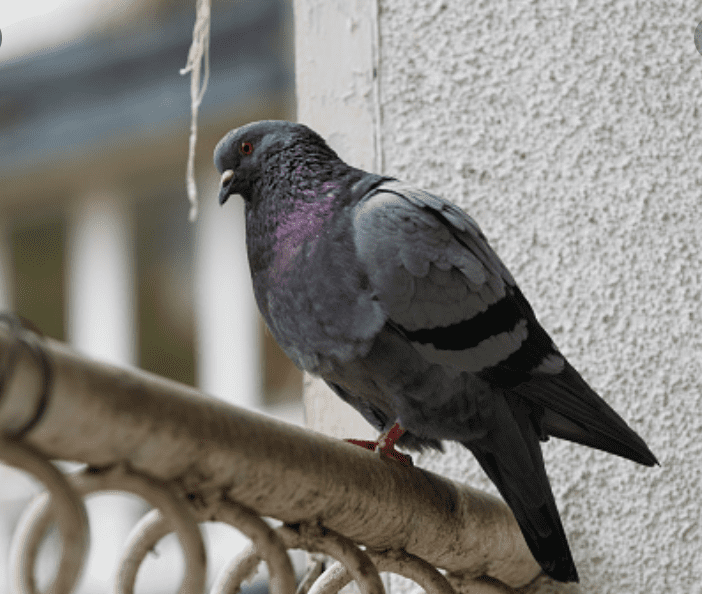
by Pigeon Patrol | Jun 14, 2023 | Bird Spike, Pigeon Droppings, Pigeon Patrol's Services, Pigeon Predators, Pigeon Spikes, Pigeons, Pigeons in the News
For half a century after WWII ended, the Swiss army refused to decommission its carrier pigeons, even though they had long outlived their usefulness.
Certain species of pigeons have an uncanny ability to find their way home to their coops from any distance. That is why pigeons were widely used to carry messages from one military unit to another in World War I and II.
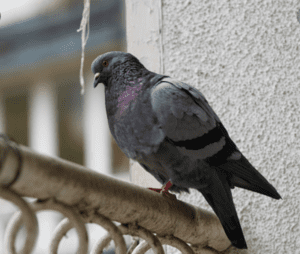
But only the Swiss army had kept its pigeons long after the war ended — until 1996. They have been on standby for decades in case of invasion— this time from the Soviet Union.
The birds “have been specially trained for homing and are used to flying long distances over all kinds of terrain,” Samuel Iselin, a spokesman for the Federal Office of Signal Troops in Bern, said just before the pigeon troops were disbanded.
But since the country had not been involved in either of the world wars, it is safe to assume that Swiss pigeons had never seen active combat duty or witnessed any frontline action.
There is also no record of any of them falling victim to enemy fire, unlike their French counterpart, Cher Ami, which was hit while delivering messages during the Battle of Verdun in 1916. She was awarded the posthumous Croix de Guerre medal for her bravery.
It is perhaps natural to think that pigeons carried messages in their beaks, like the olive branches. But in fact, messages were written on light paper, rolled into a small tube, and attached to the bird’s leg.
From 1919 until 1996, Switzerland owned 7,000 pigeons; another 23,000 were on standby to use in case of national emergency.
In the early 1990s, the Defense Ministry decided to save $476,000 a year by finally retiring the flock and focusing on more modern communication methods.
But in a truly Swiss fashion, a pro-pigeon group had collected 100,000 signatures for a referendum to enshrine the carrier pigeon service in the Swiss constitution.
In the end, however, bird enthusiasts and the army reached a compromise: a new foundation was established especially to care for the retired military pigeons in their new civilian life.
Thirty elite birds were pigeonholed, as it were, to live out their retirement in warmer climes.
They were sold to a private South African buyer, and they didn’t even have to fly to their new home themselves. “The pigeons were handed over in Zurich and put aboard a South African Airways flight,” Iselin explained.
Source
Pigeon Patrol Products & Services is the leading manufacturer and distributor or bird deterrent (control) products in Canada. Pigeon Patrol products have solved pest bird problems in industrial, commercial, and residential settings since 2000, by using safe and humane bird
deterrents with only bird and animal friendly solutions. At Pigeon Patrol, we manufacture and offer a variety of bird deterrents, ranging from Ultra-flex Bird Spikes with UV protection, Bird Netting, 4-S Bird Gel and the best Ultrasonic and audible sound devices on the market today.
Voted Best Canadian wholesaler for Bird Deterrent products ten years in a row.
Contact us at 1 877-4-NO-BIRD,(604) 585-9279 or visit our website at www.pigeonpatrol.ca
Pigeon/Pigeon Patrol / Pigeons Roosing / Vancouver Pigeon Control / Bird Spikes / Bird Control / Bird Deterrent / PIgeon Deterrent / Surrey Pigeon Control / Pest / Seagull deterrent / Vancouver Pigeon Blog / Birds Inside Home / Pigeons in the cities / Ice Pigeons / What to do about pigeons / sparrows, Damage by Sparrows, How to Keep Raccoons Away, Why Are Raccoons Considered Pests / De-fence / Pigeon Nesting / Bird Droppings / Pigeon Dropping / woodpecker control / Professional Bird Control Company / Keep The Birds Away / Birds/rats/seagull/pigeon/woodpecker/dove/sparrow/pidgeon control/pidgeon problem/pidgeon control/flying rats/pigeon problems/ bird netting/bird gel/bird spray/bird nails/bird guard
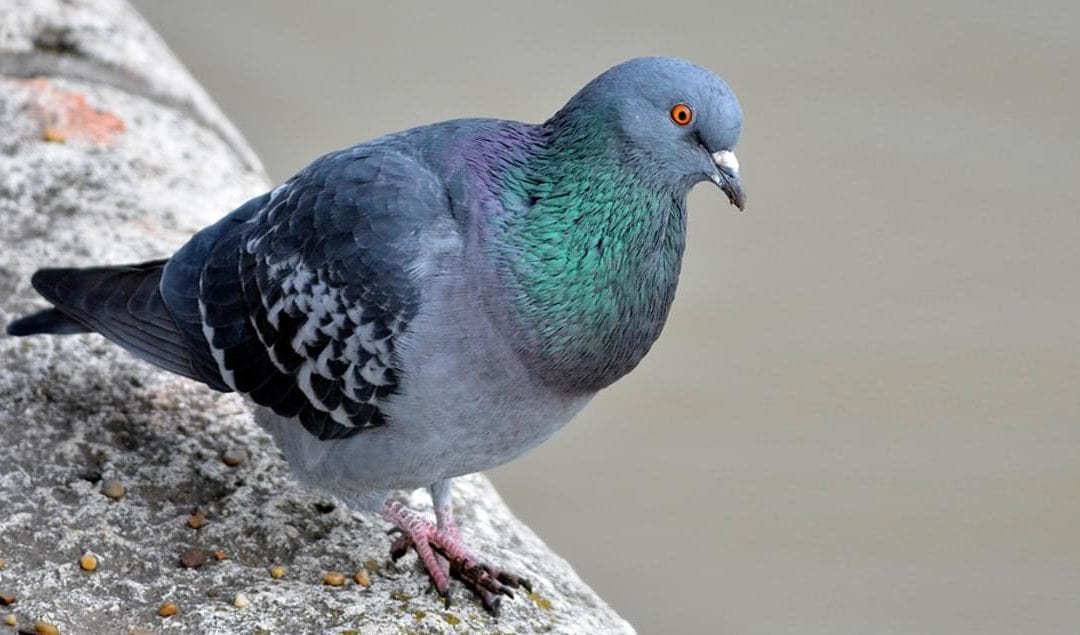
by Pigeon Patrol | Jun 14, 2023 | history of pigeons, MBCA, pet bird, Pigeon Control, Pigeon Droppings, Pigeon Patrol's Services, Pigeon Predators
A team of researchers from the University of London and Monash University has found that pigeon pecking order is driven by weight and that a given pecking order can be artificially changed. In their paper published in the journal Biology Letters, the group describes their study of the pecking order of domesticated pigeons and what they learned about them.
The term pecking order has come to be used as a way to describe the hierarchy that exists within a group of animals, including humans. Typically, those at the top of the hierarchy have better access to food or a mate, while those at the bottom must scramble to get by. In this new effort, the researchers looked at pecking order in pigeons at the Royal Veterinary College of the University of London. The pigeons housed there are used for homing purposes—nine are female and eight are male. They are all six years old and differ slightly in size. Over the course of the three-year study, the birds were given access to food and water and no other birds were included as part of the group. The group was closely watched for a period of time at three points during their annual cycle. Also, at 19 months into the study, the researchers affixed small weights to the smallest of the pigeons.
In studying the birds, the researchers found that they had a clear hierarchy, with the larger birds at the top and the smaller birds at the bottom. Those at the top of the hierarchy were first in line when food and water were given, while those lower down had to settle for less food by the time their turn came. The researchers found that the larger birds were more aggressive, which is why they got their way when feeding. Things changed dramatically, however, when the researchers added the weights to the smallest birds. With the increase in weight, the birds grew more aggressive and very quickly moved up the hierarchy, eventually arriving at the top. And they remained at the top of the hierarchy until the researchers removed the weights. At their suddenly reduced weight, the birds lost their aggressiveness and slid down to the bottom of the hierarchy once again.
The researchers note that their study shows that aggressive traits in an animal can be modified simply by changing a physical attribute such as weight. They suggest their findings indicate that people feeding bread crumbs to birds at a park may be making them more aggressive.
Source
Pigeon Patrol Products & Services is the leading manufacturer and distributor or bird deterrent (control) products in Canada. Pigeon Patrol products have solved pest bird problems in industrial, commercial, and residential settings since 2000, by using safe and humane bird
deterrents with only bird and animal friendly solutions. At Pigeon Patrol, we manufacture and offer a variety of bird deterrents, ranging from Ultra-flex Bird Spikes with UV protection, Bird Netting, 4-S Bird Gel and the best Ultrasonic and audible sound devices on the market today.
Voted Best Canadian wholesaler for Bird Deterrent products ten years in a row.
Contact us at 1 877-4-NO-BIRD,(604) 585-9279 or visit our website at www.pigeonpatrol.ca
Pigeon/Pigeon Patrol / Pigeons Roosing / Vancouver Pigeon Control / Bird Spikes / Bird Control / Bird Deterrent / PIgeon Deterrent / Surrey Pigeon Control / Pest / Seagull deterrent / Vancouver Pigeon Blog / Birds Inside Home / Pigeons in the cities / Ice Pigeons / What to do about pigeons / sparrows, Damage by Sparrows, How to Keep Raccoons Away, Why Are Raccoons Considered Pests / De-fence / Pigeon Nesting / Bird Droppings / Pigeon Dropping / woodpecker control / Professional Bird Control Company / Keep The Birds Away / Birds/rats/seagull/pigeon/woodpecker/dove/sparrow/pidgeon control/pidgeon problem/pidgeon control/flying rats/pigeon problems/ bird netting/bird gel/bird spray/bird nails/bird guard
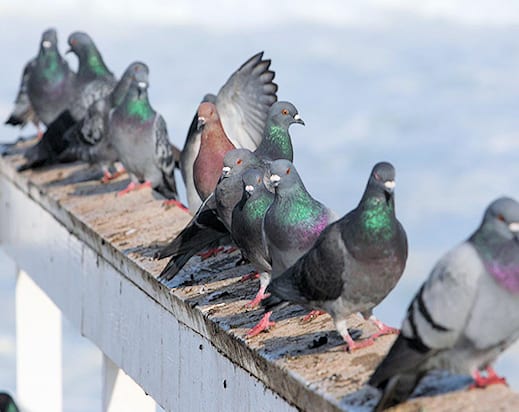
by Pigeon Patrol | May 30, 2023 | history of pigeons, MBCA, pet bird, Pigeon Control, Pigeon Droppings, Pigeon Patrol's Services, Pigeon Predators
A young woman in Fredericton is singing on the street to call attention to the disease that made her blind.
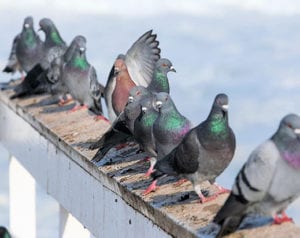
Erica Richards lost her sight last year after developing Cryptococcus meningitis.
Cryptococcus meningitis is a potentially fatal swelling of the membranes surrounding the brain. The disease is caused by fungus that lives in the guts of pigeons and other birds, such as chickens.
People can breathe it in if they’re exposed to pigeon droppings.
The 24-year-old was living in a house that had a pile of pigeon feces in the attic, and she also had a compromised immune system from chemotherapy .
“A reverse migraine — I needed light, I needed sound. I needed neck massages. Couldn’t lay down, couldn’t sit up. Couldn’t eat. I was vomiting. And then I started having double vision, quadruple vision, then seizures. And then I ended up in hospital,” she said as she described her symptoms.
Richards sings to supplement her $135 a month disability payment.
Kevin Forward is an infectious disease specialist who teaches at Dalhousie Medical School in Halifax.
“I think it’s pretty common sense. Move to avoid being in a situation where there are a lot of pigeon droppings, particularly if you’re disturbing them, cleaning them up, sweeping them,” Forward said.
“Those kind of situations should certainly be avoided. But if you’re in the park that has some pigeons around, I think the risk is infinitely small.”
Pigeons are part of the urban landscape, but they are known to carry a long list of disease-causing organisms — such as Chlamydia and salmonella.
That, along with complaints about them damaging roofs, led Fredericton to add pigeons to the city’s animal control bylaw last year.
Property owners are now prohibited from spreading feed or anything else that would attract pigeons.
Richards wants to make sure people know the risk of coming into contact with pigeon feces.
“To draw attention, to raise awareness so people will ask questions, so they will know what the symptoms are,” Richards said. “So that way, they can be warned ahead of time, before what happened to me happens to them.”
Next month, she’ll be going to a school sponsored by the Canadian National Institute for the Blind to finish high school and to get matched with a seeing-eye dog.
She hopes to go on to study law.
Source
Pigeon Patrol Products & Services is the leading manufacturer and distributor or bird deterrent (control) products in Canada. Pigeon Patrol products have solved pest bird problems in industrial, commercial, and residential settings since 2000, by using safe and humane bird
deterrents with only bird and animal friendly solutions. At Pigeon Patrol, we manufacture and offer a variety of bird deterrents, ranging from Ultra-flex Bird Spikes with UV protection, Bird Netting, 4-S Bird Gel and the best Ultrasonic and audible sound devices on the market today.
Voted Best Canadian wholesaler for Bird Deterrent products ten years in a row.
Contact us at 1 877-4-NO-BIRD,(604) 585-9279 or visit our website at www.pigeonpatrol.ca
Pigeon/Pigeon Patrol / Pigeons Roosing / Vancouver Pigeon Control / Bird Spikes / Bird Control / Bird Deterrent / PIgeon Deterrent / Surrey Pigeon Control / Pest / Seagull deterrent / Vancouver Pigeon Blog / Birds Inside Home / Pigeons in the cities / Ice Pigeons / What to do about pigeons / sparrows, Damage by Sparrows, How to Keep Raccoons Away, Why Are Raccoons Considered Pests / De-fence / Pigeon Nesting / Bird Droppings / Pigeon Dropping / woodpecker control / Professional Bird Control Company / Keep The Birds Away / Birds/rats/seagull/pigeon/woodpecker/dove/sparrow/pidgeon control/pidgeon problem/pidgeon control/flying rats/pigeon problems/ bird netting/bird gel/bird spray/bird nails/bird guard
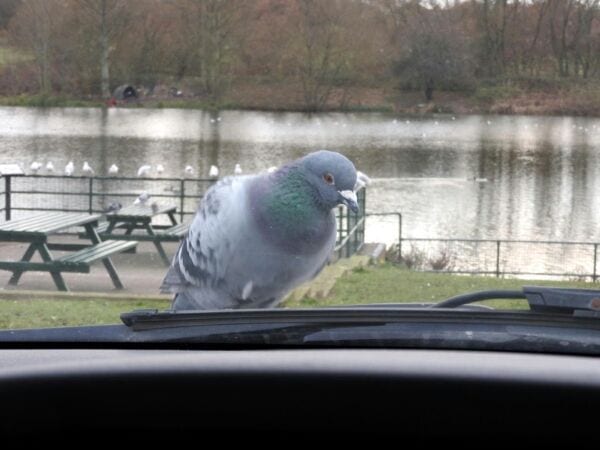
by Pigeon Patrol | May 30, 2023 | history of pigeons, MBCA, pet bird, Pigeon Control, Pigeon Droppings, Pigeon Patrol's Services, Pigeon Predators
In the span of a few weeks, Erica Richards has been transformed from a vibrant 23-year-old woman who loved nature to a person battling for her life.
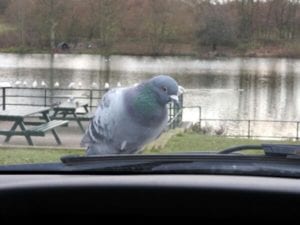
In early January, the Fredericton woman contracted a potentially fatal condition called cryptococcal meningitis, a fungal disease carried in the feces of pigeons.
The debilitating illness attacks the spine and brain, causing severe swelling. It left her confined to a hospital bed in a state of delirium for weeks.
But the most devastating side effect is that Ms. Richards is now blind.
“Be aware of this disease. It could kill a child in a heartbeat,” Ms. Richards said in an interview from her hospital bed.
“It could kill a senior in a heartbeat without you even having to worry about the symptoms. It comes on that fast. If you don’t realize the symptoms, it could kill you, too.”
Her emotional warning comes on the heels of city council’s approval earlier this month of a recommendation that it toughen its animal control bylaw to allow for fines for feeding pigeons. Once the amendment is drafted and declared law, it will give the city’s bylaw enforcement officers the power to ticket and fine offenders.
Ms. Richards said she decided to go public about her illness after learning about a recent newspaper story about a problem with pigeon poop in the city.
“Please don’t feed the pigeons,” she said. “Try to shoo them away if you see them. … It (the disease) is horrible. The pain that you get from this disease is crippling.
“The after-effects are with you for life and you just can’t stop thinking about it. I just want other people to know and try to stay away from pigeons.”
Oddly enough, Ms. Richards said she has no recollection of ever being anywhere near pigeons.
“I am still wondering to this day where I got it,” she said. “I could have stepped in it and brought it into the home. I just don’t know.”
Ms. Richards said the symptoms started with a migraine headache that wouldn’t go away. She was admitted to hospital on Feb. 10 after many days of intense head pain. Shortly after, she went into a coma-like state.
“When I woke up I thought I had a mask over my eyes, but I was wrong. I was blind. I was recently told that I will be blind for the rest of my life. This is a tough thing for a 23-year-old to go through. … My world crumbled around me.”
Ms. Richards said the odds of surviving the disease are 50-50.
“However, I managed to make it through,” she said, battling tears. “I don’t know how but I am still here, and I am glad because I get to warn everyone else of this.”
Cristin Muecke, the Health Department’s regional medical officer, confirmed the disease is often associated with pigeon droppings. She said the illness can’t be spread person to person and is more common with someone who has immune problems.
Ms. Richards, however, said she has never had a problem with her immune system and that’s what’s so puzzling about contracting the affliction.
“I do not want anyone else to suffer this agonizing disease and I ask anyone who is feeding pigeons to stop,” she said. “It’s not just a matter of keeping your neighbourhood clean … it’s a matter of keeping people healthy.”
Source
Pigeon Patrol Products & Services is the leading manufacturer and distributor or bird deterrent (control) products in Canada. Pigeon Patrol products have solved pest bird problems in industrial, commercial, and residential settings since 2000, by using safe and humane bird
deterrents with only bird and animal friendly solutions. At Pigeon Patrol, we manufacture and offer a variety of bird deterrents, ranging from Ultra-flex Bird Spikes with UV protection, Bird Netting, 4-S Bird Gel and the best Ultrasonic and audible sound devices on the market today.
Voted Best Canadian wholesaler for Bird Deterrent products ten years in a row.
Contact us at 1 877-4-NO-BIRD,(604) 585-9279 or visit our website at www.pigeonpatrol.ca
Pigeon/Pigeon Patrol / Pigeons Roosing / Vancouver Pigeon Control / Bird Spikes / Bird Control / Bird Deterrent / PIgeon Deterrent / Surrey Pigeon Control / Pest / Seagull deterrent / Vancouver Pigeon Blog / Birds Inside Home / Pigeons in the cities / Ice Pigeons / What to do about pigeons / sparrows, Damage by Sparrows, How to Keep Raccoons Away, Why Are Raccoons Considered Pests / De-fence / Pigeon Nesting / Bird Droppings / Pigeon Dropping / woodpecker control / Professional Bird Control Company / Keep The Birds Away / Birds/rats/seagull/pigeon/woodpecker/dove/sparrow/pidgeon control/pidgeon problem/pidgeon control/flying rats/pigeon problems/ bird netting/bird gel/bird spray/bird nails/bird guard







